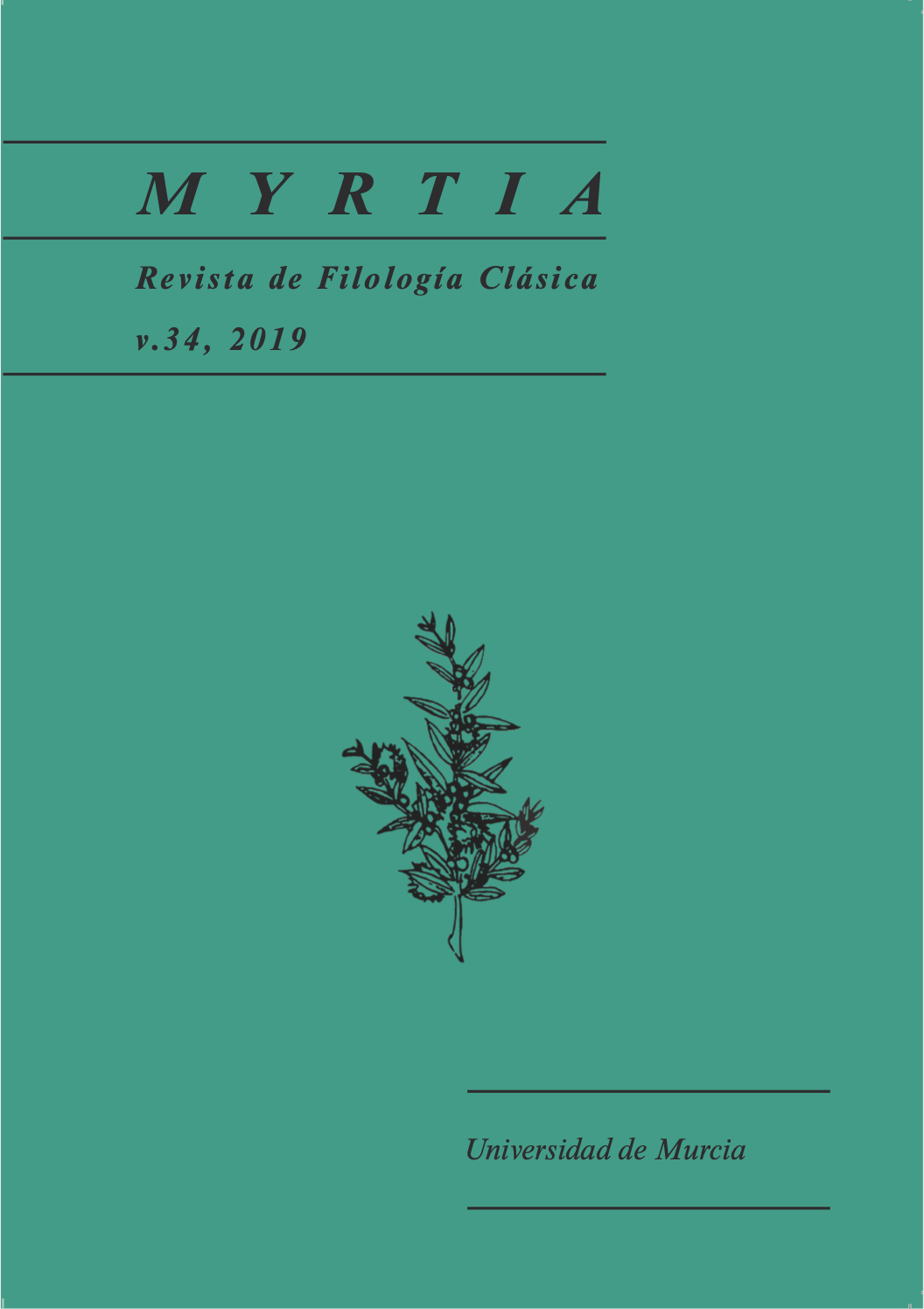Nymphaeque sorores: Virgil’s Sororities of Nymphs
Resumen
Nymphs appear frequently in the corpus of Virgilian poetry. Careful consideration of the place of nymphs in Virgil’s Eclogues and (in particular) his Georgics reveals how the poet utilizes these quasi-divine figures as important elements of his exposition of both the nature of Roman identity and the demands incurred in composing his Homeric-Callimachean epic.
Descargas
-
Resumen454
-
PDF 512
Citas
AUSTIN, R.G., 1971. P. Vergilius Maro Aeneidos Liber Primus. Oxford.
AUSTIN, R.G., 1955. P. Vergilius Maro Aeneidos Liber Quartus. Oxford.
BAILEY, C., 1935. Religion in Virgil. Oxford.
BALK, C., 1968. Die Gestalt des Latinus in Vergils Aeneis. Heidelberg.
BASSON, W.P., 1975. Pivotal Catalogues in Virgil’s Aeneid. Amsterdam: Adolf M. Hakkert.
BUSCAROLI, C., 1932. Il libro di Didone. Milano: Società Anonima Editrice Dante Alighieri.
COLEMAN, R., 1977. Vergil: Eclogues. Cambridge.
CONTE, G.B., 2009. P. Vergilius Maro Aeneis. Berlin-New York: Walter de Gruyter.
CUCCHIARELLI, A., 2012. Publio Virgilio Marone: Le Bucoliche, Introduzione e comment. Roma: Carocci Editore.
DAVIES, M., 2014. The Theban Epics. Cambridge, Massachusetts: Harvard University Press.
DAVIS, G., 1983. The Death of Procris: Amor and the Hunt in Ovid’s Metamorphoses. Roma: Edizioni dell’Ateneo.
DELLA CORTE, F., 1984-1991. Enciclopedia virgiliana. Roma: Istituto della Enciclopedia Italiana.
DINGEL, J.., 1997. Kommentar zum 9. Buch der Aeneis Vergils. Heidelberg.
DOVER, K., 1971. Theocritus: Select Poems. London: Macmillan.
EDGEWORTH, R.J., 1992. The Colors of the Aeneid. New York: Peter Lang.
ERREN, M., 2003. P. Vergilius Maro Georgica, Band 2 Kommentar. Heidelberg.
FRATANTUONO, L., 2009. “Chiastic Doom in the Aeneid,” in Latomus 68.2, pp. 393-401.
FRATANTUONO, L., 2011. “Decus Fluviorum: Juturna in the Aeneid,” in Athenaeum 99.1, pp. 27-39.
FRATANTUONO, L., 2017. “Pallasne exurere classem: Minerva in the Aeneid,” in Arctos 51, pp. 63-88.
FRATANTUONO, L., and MCOSKER, M., 2010. “Camilla and Cydippe: A Note on Aeneid 11, 581-582,” in QUCC 96.3, pp. 111-116.
FRATANTUONO, L., and SMITH, R., 2018. Virgil: Aeneid 8, Text, Translation, and Commentary. Leiden-Boston: Brlll.
GANTZ, T., 1993. Early Greek Myth. Baltimore-London: The Johns Hopkins University Press.
GRASSMAN-FISCHER, B., 1966. Die Prodigien in Vergils Aeneis. München: Wilhelm Fink Verlag.
HARDIE, P., 1994. Virgil: Aeneid Book IX. Cambridge.
HARRISON, S.J., 1991. Vergil: Aeneid 10. Oxford.
HENRY, E., 1989. The Vigour of Prophecy: A Study of Virgil’s Aeneid. Carbondale, Illinois: Southern Illinois University Press.
HEUZÉ, P., 1985. L’image du corps dans l’œuvre de Virgile. Roma: École française de Rome.
HEYWORTH, S.J., and MORWOOD, J.H., 2017. A Commentary on Vergil, Aeneid 3. Oxford.
HIGHET, G., 1972. The Speeches in Vergil’s Aeneid. Princeton.
HORNBLOWER, S., 2015. Lykophron: Alexandra. Oxford.
HORSFALL, N., 2000. Virgil, Aeneid 7: A Commentary. Leiden-Boston-Köln: Brill.
HORSFALL, N., 2006. Virgil, Aeneid 3: A Commentary. Leiden-Boston: Brill.
HUNTER, R., 1999. Theocritus: A Selection. Cambridge.
JONES, F., 2011. Virgil’s Garden: The Nature of Bucolic Space. London: Bristol Classical Press.
JONES, P.J., 2005. Reading Rivers in Roman Literature and Culture. Lanham, Maryland: Lexington Books.
KEPPLE, L.R., 1976. “Arruns and the Death of Aeneas,” in AJP 97.4, pp. 344-360.
LARSON, J., 1997. “Handmaidens of Artemis?,” in CJ 92.3, pp. 249-257.
LARSON, J., 2001. Greek Nymphs: Myth, Cult, Lore. Oxford.
LIGHTFOOT, J. L., 1999. Parthenius of Nicaea. Oxford.
LIGHTFOOT, J.L., 2009. Hellenistic Collection. Cambridge, Massachusetts: Harvard University Press.
MILES, G.B., 1980. Virgil’s Georrgics: A New Interpretation. Berkeley-Los Angeles-London: The University of California Press.
MORGAN, L., 1999. Patterns of Redemption in Virgil’s Georgics. Cambridge.
MYNORS, R.A.B., 1990. Virgil: Georgics. Oxford.
NEWMAN, J.K., and NEWMAN, F.S., 2005. Troy’s Children: Lost Generations in Virgil’s Aeneid. Zürich-New York: Georg Olms Verlag.
OTTAVIANO, S., and CONTE, G.B., 2013. P. Vergilius Maro: Bucolica, Georgica. Berlin-New York: Walter de Gruyter.
PASCHALIS, M., 1997. Virgil’s Aeneid: Semantic Relations and Proper Names. Oxford.
PEASE, A.S., 1935. Publi Vergili Maronis Aeneidos Liber Quartus. Cambridge, Massachusetts: Harvard University Press.
PUTNAM, M.C.J., 1970. Virgil’s Pastoral Art: Studies in the Eclogues. Princeton.
PUTNAM, M.C.J., 1979. Virgil’s Poem of the Earth: Studies in the Georgics. Princeton.
RENGER, C., 1985. Aeneas und Turnus: Analyse einer Feindschaft. Frankfurt am Main: Peter Lang.
RUMPF, L., 1996. Extremus labor: Vergils 10. Ekloge und die Poetik der Bucolica. Göttingen: Vandenhoeck & Ruprecht.
SCHENK, P., 1983. Die Gestalt des Turnus in Vergils Aeneis. Königstein: Verlag Anton Hain.
SCHMELING, G., 2011. A Commentary on the Satyrica of Petronius. Oxford.
STEPHENS, S.A., 2015. Callimachus: The Poems. Oxford.
TARRANT, R., 2012. Virgil: Aeneid, Book XII. Cambridge.
THOMAS, J., 1981. Structures de l’imaginaire dans l’Énéide. Paris: Les Belles Lettres.
THOMAS, R., 1988. Virgil: Georgics. Cambridge.
THOMAS, R., 1999. Reading Virgil and His Texts: Studies in Intertextuality. Ann Arbor: The University of Michigan Press.
THOMAS, R., and ZIOLKOWSKI, J. 2014. The Virgil Encyclopedia. Malden, Massachusetts: Wiley-Blackwell.
TRAINA, A., 2017. Virgilio: L’utopia e la storia. Bologna: Patrón Editore.
ZITO, N., 2016. Maxime: Des initiatives. Paris: Les Belles Lettres.
Las obras que se publican en esta revista están sujetas a los siguientes términos:
1. El Servicio de Publicaciones de la Universidad de Murcia (la editorial) conserva los derechos patrimoniales (copyright) de las obras publicadas, y favorece y permite la reutilización de las mismas bajo la licencia de uso indicada en el punto 2.
2. Las obras se publican en la edición electrónica de la revista bajo una licencia Creative Commons Reconocimiento-NoComercial-SinObraDerivada 3.0 España (texto legal). Se pueden copiar, usar, difundir, transmitir y exponer públicamente, siempre que: i) se cite la autoría y la fuente original de su publicación (revista, editorial y URL de la obra); ii) no se usen para fines comerciales; iii) se mencione la existencia y especificaciones de esta licencia de uso.
3. Condiciones de auto-archivo. Se permite y se anima a los autores a difundir electrónicamente las versiones pre-print (versión antes de ser evaluada) y/o post-print (versión evaluada y aceptada para su publicación) de sus obras antes de su publicación, ya que favorece su circulación y difusión más temprana y con ello un posible aumento en su citación y alcance entre la comunidad académica. Color RoMEO: verde.





